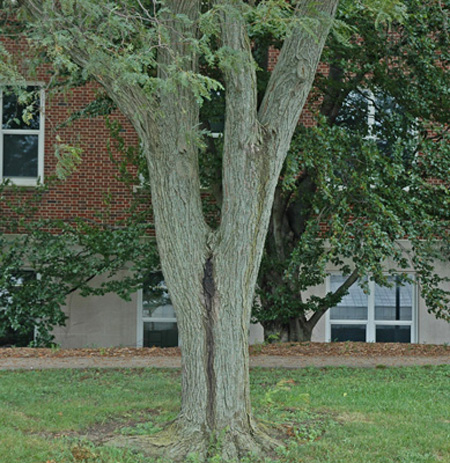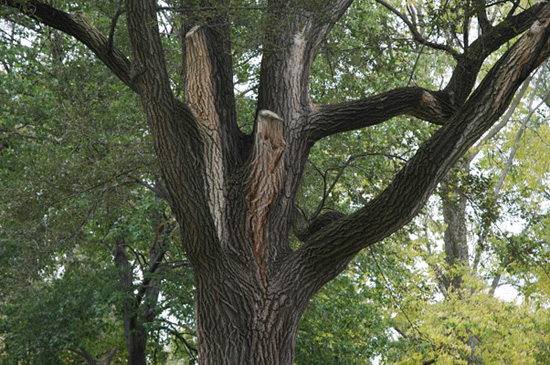Issue 10, June 26, 2009
Wetwood and Slime Flux
Until now, I had never thought about what weather conditions would promote wetwood and slime flux. Possibly wet weather is involved, but more likely increased incidents of slime flux now has to do with increased sap flow of trees in the spring and early summer. Admittedly I am going out on a limb here (pun intended).
Wetwood and slime flux is a chronic disease of trees that can contribute to general decline in tree vitality. It is not known to cause tree death. It is probably most common on elm in Illinois, but we see it on many other trees including oak, poplar, cottonwood, maple, redbud, sycamore, and other species. There are at least four bacteria associated with wetwood, the most common being Enterobacter nimipressuralis. The bacterium gains entry into the tree, usually through wounds and especially in the roots, where it ferments and causes internal pressure. Moisture containing the bacterium will flow from cracks, wounds, or weak areas in the tree. The usual place is in crotches of the tree as seen in the honeylocust image. Other times oozing comes from branch stubs as seen in the elm image. The smell that sometimes develops is usually due to secondary rotting organisms. Although this problem cannot be cured, it is comforting to know that the wet regions are not decayed. Decay fungi do not thrive in this water-soaked wood.

Honeylocust tree.

Elm tree.
The wound that allowed entry of the bacteria may not be visible. What we see on the tree is a wet area of "bleeding" liquid that drips, flows, or oozes out of the tree. Bacteria in the inner sapwood and heartwood of the tree ferment, causing internal gas pressure. This pressure commonly reopens old wounds and the sour liquid flows down the bark. As it dries, a light gray/white encrustation remains. This encrustation is called slime flux. The liquid commonly causes localized death of the cambium. Although fluxing occurs from April to December, it is most conspicuous in the summer.
Wetwood does not kill trees, but it is associated with older trees, often in decline. There is no cure for this condition, but the following may be helpful. Fertilize stressed trees in the spring or fall to stimulate vigorous growth. Removing dead or weak branches, plus promptly pruning and shaping bark wounds is helpful. Proper pruning techniques will encourage rapid callousing of wounds. The sap flow that results from pruned branches is normal and is not the same as wetwood flow. The liquid we see with wetwood may flow year-round and is often followed by the foul smelling slime flux described. We do not condone the use of pipes to "drain" this flow. Pipes are often used to get the liquid off the trunk, but the process of inserting the pipe may cause further injury within the trunk. Consult RPD No. 656, Bacterial Wetwood and Slime Flux of Landscape Trees for more on this condition. The report is available on line free of charge.--Nancy Pataky
Author:
Nancy Pataky